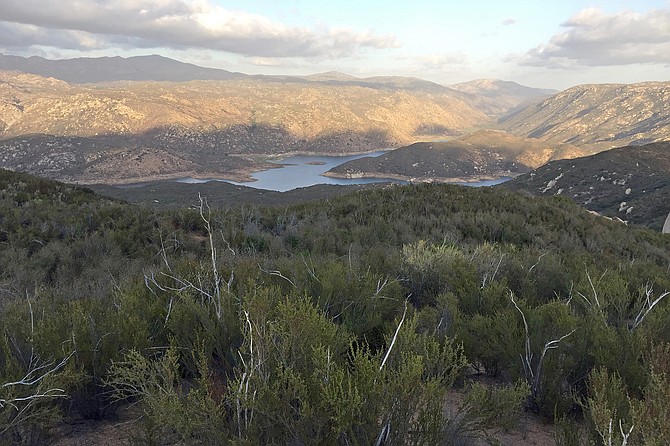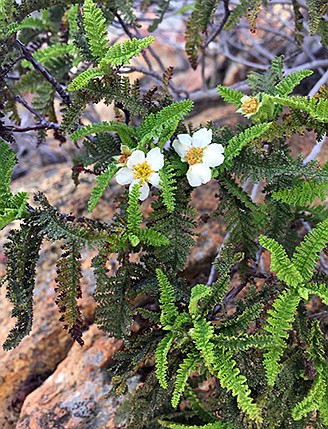 Facebook
Facebook
 X
X
 Instagram
Instagram
 TikTok
TikTok
 Youtube
Youtube

Before the major wildfires of 2003 and 2007 and the installation of the Sunrise Power Link, Barber Mountain Road was a jeep road that connected upper Deerhorn Valley to Honey Springs Road. Since that time, private property interests on Honey Springs Road have closed that end of the trail, and the only official entry is found at a National Forest hiking and riding gate at the end of Cinnamon Drive. Cinnamon Drive is a rough dirt road and there is very limited (maybe three cars) parking in a tight turnaround at the trailhead. If you make the journey, a hike through some very wild country is your reward.
Barber Mountain Trail/Forest Route 17S10 sees very little foot traffic. The old truck road is used primarily for SDG&E access to its power lines, border patrol, and fire response. As the trail meanders away from the gate, you’ll see many low guardrails to prevent off-road vehicles from leaving the main trail—even though motorized vehicles aren’t legally supposed to be there in the first place.
The route winds past power towers, and within a mile, dips into a visible oak canyon—the only tree-shade along the entire road. An old trail leads down into this canyon on the right (east) and eventually to an overlook of Barrett Lake, but the trail is overgrown in many places with poison oak—likely the reason this old favorite of horseback riders has been abandoned. Continuing along the road, hike along a bank of wild lilac (Ceanothus) before switchbacking up the road and turning sharply west. At the last and highest switchback, a steep and nasty trail will take you to a rise where you can look down at Barrett Lake. Remember, coming down is going to be harder. And be on the alert for rattlesnakes; this area supports southern Pacific, red diamond, and southwestern speckled rattlers.

While making the long climb up the road, keep an eye on the left bank (south). A small population of the gabbro soil-preferring southern mountain misery (Chamaebatia australis) can be found there, along with blue hyacinth, monkey flowers, and mariposa lilies. In spring, this trail can be adorned on both sides with white, yellow, purple, and red wildflowers. The song of the elusive wrentit, often called the call of the chaparral, will be mixed with that of spotted towhees, California towhees, and canyon wrens.
It’s hard to believe that much of this area was completely burned in 2017. The hardy chaparral has recovered, with California buckwheat (Eriogonum fasciculatum), chamise (Adenostoma fasciculatum), laurel sumac (Malosma laurina), scrub oak (Quercus berberidifolia), mountain mahogany (Cercocarpus betuloides), and chaparral beard tongue (Keckiella antirrhinoides) creating a dense shrub forest. Flowering annuals and perennials such as California fuchsia (Epilobium canum), Parry’s phacelia (Phacelia parryi), wishbone plant (Mirabilis laevis var. crassifolia), nightshade (Solanum xanti), yarrow (Achillea millefolium), and deer weed (Acmispon glaber) dress the sides of the road.
This area is also home to coyotes, bobcats, and mountain lions, often seen, but not disturbed, by those who live near this wilderness interface. The land around Barrett Lake supports a large population of mule deer and many other animals that rely on the year-round water.
The trail climbs steadily, passing at the foot of Barber (3,250 feet) and Elena (3,310 feet) mountains. These peaks can be climbed if you are up for some serious bushwhacking to reach the summit. The views to the west are vast, unpopulated, and wild, supporting dense stands of mixed chaparral and canyons of oak trees, poison oak, and seasonal creeks.
Lawson Peak (3,563 feet) and Gaskill Peak (3,780 feet) can be seen on the other side of Lyons Valley to the north. The formidable dark-green vegetation is broken by thousands of granitic boulders and white slabs reflecting the mid-day sun.
This area offers little shade. To cover the entire route in a day, bring plenty of water for yourself and your canine companion. (If you take a dog, be sure to keep it on a leash. Snakes are plentiful, and so are ticks, and wildlife will tempt your dog to venture into the scrub.) If an emergency should arise, there are only a few spots where you can get cell service.
If you are not sure how far you want to go, keep in mind the old desert hiking tip: go no farther than one-third of your water. When you have sipped one-third of your water, turn around and go back, saving two-thirds for the hike back. Once you see the cars passing on Honey Springs Road (mile 5), it’s the end of the line. The long walk back is mostly downhill—except for the last-mile climb back to the parking area!

BARBER MOUNTAIN TRAIL (Cleveland National Forest)
Walk through miles of unspoiled chaparral and uninhabited vistas.


Before the major wildfires of 2003 and 2007 and the installation of the Sunrise Power Link, Barber Mountain Road was a jeep road that connected upper Deerhorn Valley to Honey Springs Road. Since that time, private property interests on Honey Springs Road have closed that end of the trail, and the only official entry is found at a National Forest hiking and riding gate at the end of Cinnamon Drive. Cinnamon Drive is a rough dirt road and there is very limited (maybe three cars) parking in a tight turnaround at the trailhead. If you make the journey, a hike through some very wild country is your reward.
Barber Mountain Trail/Forest Route 17S10 sees very little foot traffic. The old truck road is used primarily for SDG&E access to its power lines, border patrol, and fire response. As the trail meanders away from the gate, you’ll see many low guardrails to prevent off-road vehicles from leaving the main trail—even though motorized vehicles aren’t legally supposed to be there in the first place.
The route winds past power towers, and within a mile, dips into a visible oak canyon—the only tree-shade along the entire road. An old trail leads down into this canyon on the right (east) and eventually to an overlook of Barrett Lake, but the trail is overgrown in many places with poison oak—likely the reason this old favorite of horseback riders has been abandoned. Continuing along the road, hike along a bank of wild lilac (Ceanothus) before switchbacking up the road and turning sharply west. At the last and highest switchback, a steep and nasty trail will take you to a rise where you can look down at Barrett Lake. Remember, coming down is going to be harder. And be on the alert for rattlesnakes; this area supports southern Pacific, red diamond, and southwestern speckled rattlers.

While making the long climb up the road, keep an eye on the left bank (south). A small population of the gabbro soil-preferring southern mountain misery (Chamaebatia australis) can be found there, along with blue hyacinth, monkey flowers, and mariposa lilies. In spring, this trail can be adorned on both sides with white, yellow, purple, and red wildflowers. The song of the elusive wrentit, often called the call of the chaparral, will be mixed with that of spotted towhees, California towhees, and canyon wrens.
It’s hard to believe that much of this area was completely burned in 2017. The hardy chaparral has recovered, with California buckwheat (Eriogonum fasciculatum), chamise (Adenostoma fasciculatum), laurel sumac (Malosma laurina), scrub oak (Quercus berberidifolia), mountain mahogany (Cercocarpus betuloides), and chaparral beard tongue (Keckiella antirrhinoides) creating a dense shrub forest. Flowering annuals and perennials such as California fuchsia (Epilobium canum), Parry’s phacelia (Phacelia parryi), wishbone plant (Mirabilis laevis var. crassifolia), nightshade (Solanum xanti), yarrow (Achillea millefolium), and deer weed (Acmispon glaber) dress the sides of the road.
This area is also home to coyotes, bobcats, and mountain lions, often seen, but not disturbed, by those who live near this wilderness interface. The land around Barrett Lake supports a large population of mule deer and many other animals that rely on the year-round water.
The trail climbs steadily, passing at the foot of Barber (3,250 feet) and Elena (3,310 feet) mountains. These peaks can be climbed if you are up for some serious bushwhacking to reach the summit. The views to the west are vast, unpopulated, and wild, supporting dense stands of mixed chaparral and canyons of oak trees, poison oak, and seasonal creeks.
Lawson Peak (3,563 feet) and Gaskill Peak (3,780 feet) can be seen on the other side of Lyons Valley to the north. The formidable dark-green vegetation is broken by thousands of granitic boulders and white slabs reflecting the mid-day sun.
This area offers little shade. To cover the entire route in a day, bring plenty of water for yourself and your canine companion. (If you take a dog, be sure to keep it on a leash. Snakes are plentiful, and so are ticks, and wildlife will tempt your dog to venture into the scrub.) If an emergency should arise, there are only a few spots where you can get cell service.
If you are not sure how far you want to go, keep in mind the old desert hiking tip: go no farther than one-third of your water. When you have sipped one-third of your water, turn around and go back, saving two-thirds for the hike back. Once you see the cars passing on Honey Springs Road (mile 5), it’s the end of the line. The long walk back is mostly downhill—except for the last-mile climb back to the parking area!

BARBER MOUNTAIN TRAIL (Cleveland National Forest)
Walk through miles of unspoiled chaparral and uninhabited vistas.